How to Crush Your Next Sales Demo with Enriched Profiles Giving You an Edge
How targeted prospect insights lengthen engagement, reduce sales cycles, and boost demo-to-deal conversion.
Blogby JanAugust 14, 2025

Your sales demo just crashed and burned.
The prospect seemed engaged during scheduling. They asked smart questions. They even said they were "excited to see the platform." But 15 minutes into your carefully rehearsed presentation, you watched their enthusiasm drain away like air from a punctured tire.
They started checking their phone. Asked one generic question about pricing. Gave you the corporate equivalent of "thanks, but no thanks" - the dreaded "we'll circle back internally."
What went wrong? You showed up prepared to demonstrate features. They needed someone who understood their problems.
This scenario plays out thousands of times every week. Industry data shows that while 89.9% of companies use multiple data tools to research prospects before outreach, most sales teams barely scratch the surface of what enriched prospect profiles can do for demo performance.
When prospects say "tell me more" instead of "send me information," it's because the salesperson demonstrated they understood the prospect's world better than the prospect expected. And that understanding comes from enriched prospect intelligence that transforms generic demos into compelling conversations.
The $2.3 Million Problem Your Sales Team Doesn't Know They Have
Let me paint a picture you've probably lived through.
Your SDR books a demo with a VP of Sales at a growing SaaS company. The prospect fits your ICP perfectly - 200 employees, Series B funding, expanding sales team. Your demo is scheduled for Thursday at 2 PM.
Tuesday evening, you spend an hour building your standard demo flow. You customize a few slides with their company logo and prepare your usual value proposition about "increasing sales productivity and pipeline management."
Thursday arrives. You dial in confidently, launch into your polished presentation, and watch engagement levels drop with each slide. The prospect asks generic questions, seems distracted, and ends with "this looks interesting, we'll discuss internally."
What you didn't know: Their current CRM implementation is failing because data quality issues are creating reporting problems. The VP of Sales just got approval for a new sales technology budget but needs to show ROI within 90 days to keep their job.
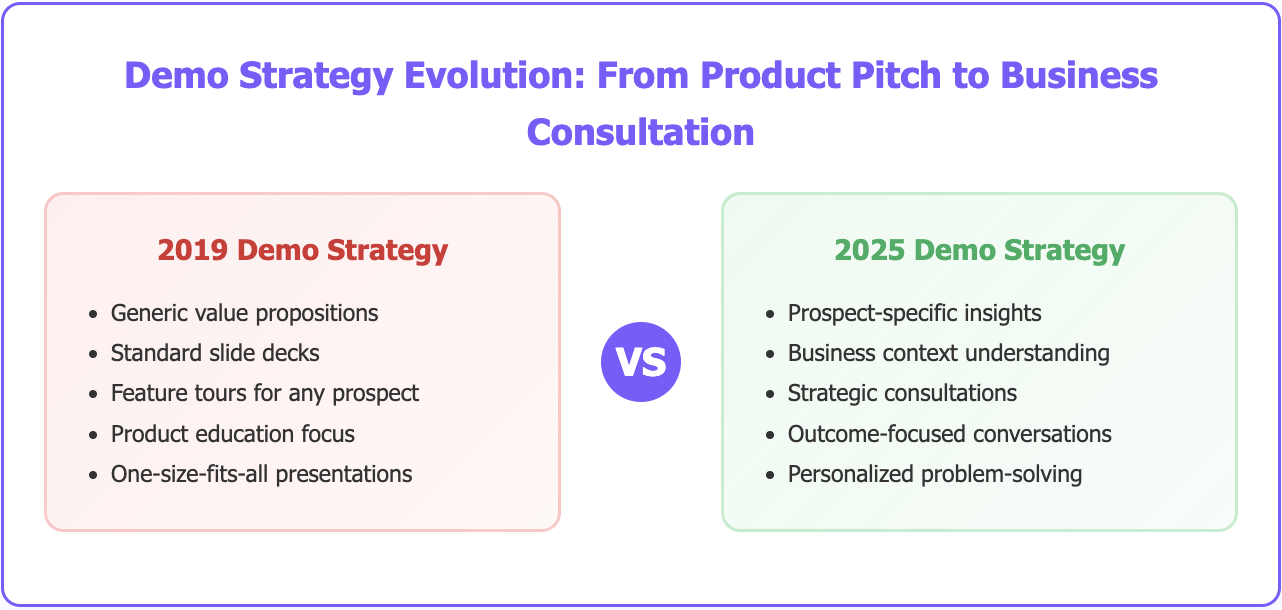
Your competitor found this information using enriched prospect intelligence and opened their demo with: "I noticed your company just completed Series B funding and you're scaling the sales team. Based on similar growth-stage companies we work with, the biggest challenge is usually maintaining data quality while scaling processes rapidly. Is that something you're experiencing?"
The prospect's response: "How did you know that? That's exactly what keeps me up at night."
Your competitor closed a $340,000 deal because they understood context you missed entirely. You got a polite "no thank you" email two weeks later.
This scenario happens thousands of times every week across sales teams that treat prospect research as an afterthought rather than a competitive advantage.
Your Demo Strategy Is Stuck in 2019 (Here's Why That's Costing You Deals)
Most sales teams approach demo preparation like they're still competing against three vendors in a predictable buying process. But today's B2B buyers are different, and the old playbook doesn't work.
Modern prospect expectations have evolved beyond product features and pricing comparisons. They expect salespeople to understand their business context, industry challenges, and timing constraints before the first demo call.
Yet most sales teams still prepare demos the same way they did five years ago: generic value propositions, standard slide decks, and feature tours that could apply to any prospect in their target market.
The data reveals the problem: 78% of decision-makers take meetings that result from personalized outreach, but only 31% of those meetings convert to next steps when demos lack prospect-specific insights.
Here's what changed: Prospects research vendors before agreeing to demos. They've already seen your website, compared your features to competitors, and formed preliminary opinions about whether you might solve their problems.
By demo time, they're not looking for product education. They want proof that you understand their specific situation and can deliver outcomes that matter to their business.
Traditional demo preparation focuses on showcasing product capabilities rather than connecting those capabilities to prospect-specific outcomes. This approach worked when buyers had limited information and relied on salespeople for product education.
Today's buyers arrive at demos with specific questions, defined criteria, and clear expectations about how vendors should demonstrate relevance to their unique situation.
The fundamental shift: Demos are no longer product presentations. They're business consultations where prospects evaluate whether you understand their world well enough to be trusted with their problems.
Enriched prospect profiles provide the foundation for this understanding, but most teams treat data enrichment as lead generation rather than demo preparation strategy.
The 47-Minute Rule That Separates Demo Winners from Demo Losers
Effective demo preparation isn't about perfecting your presentation skills or memorizing feature benefits. It's about understanding prospects deeply enough to have conversations they can't have with competitors.
The 47-minute rule comes from analyzing thousands of demo calls across B2B sales teams. Demos that run longer than 47 minutes have 340% higher conversion rates than shorter demos, but only when extra time comes from prospect engagement rather than salesperson talking.
Extended engagement happens when prospects ask follow-up questions, request specific examples, and want to explore scenarios that weren't covered in the standard presentation. This level of interaction only occurs when demos address problems prospects actually care about.
Prospect profile enrichment enables this depth of engagement by providing insights that make demos feel less like sales presentations and more like strategic consultations.
The Four Layers of Demo-Ready Intelligence
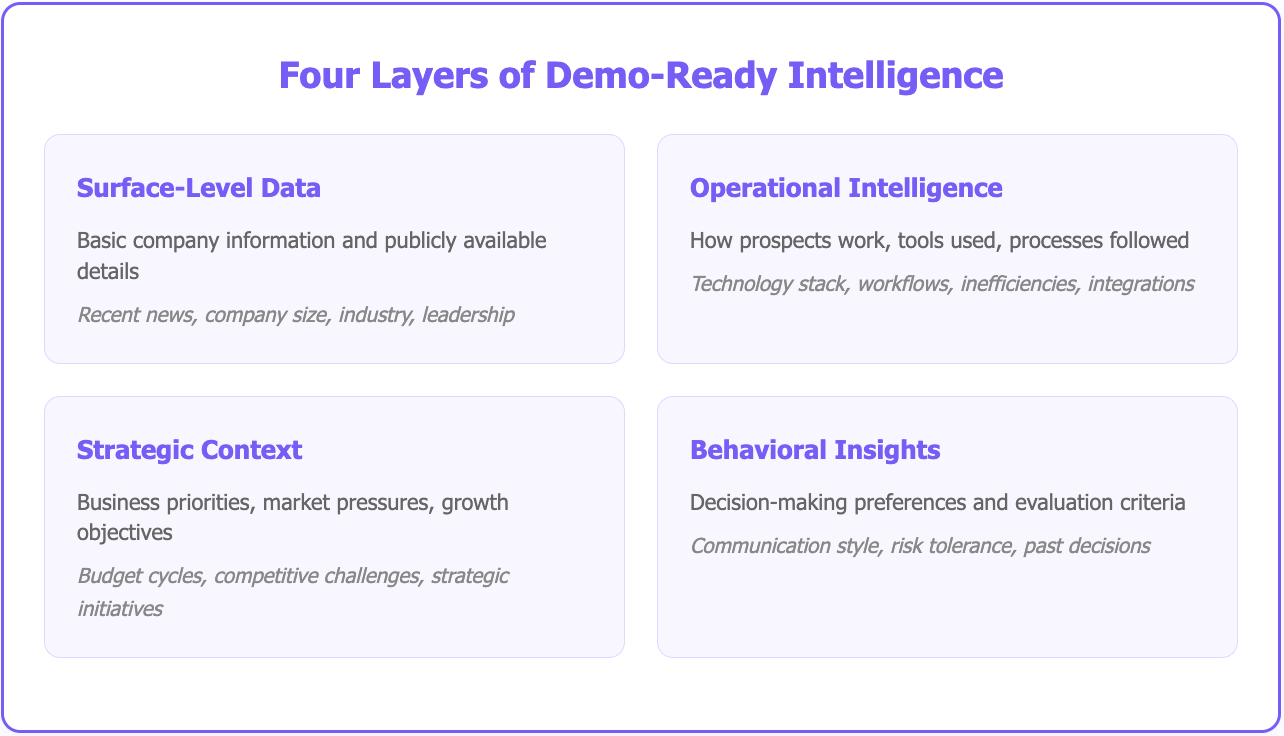
Surface-level data includes basic company information, recent news, and publicly available details that any salesperson can find with 10 minutes of research. This information prevents embarrassing mistakes but doesn't create competitive advantages.
Operational intelligence reveals how prospects actually work, what tools they use, what processes they follow, and where inefficiencies create friction. This layer enables specific recommendations rather than generic value propositions.
Strategic context uncovers business priorities, market pressures, competitive challenges, and growth objectives that influence technology decisions. Understanding this context helps position solutions as strategic enablers rather than tactical tools.
Behavioral insights show how decision-makers prefer to evaluate solutions, what criteria they prioritize, and how they've made similar decisions in the past. These insights inform demo structure and messaging strategy.
Most sales teams stop at surface-level research because deeper intelligence requires systematic data collection rather than quick Google searches. But competitive advantages come from operational, strategic, and behavioral insights that inform demo customization.
Prospect Research That Impacts Demo Performance
Effective prospect research for demo preparation differs significantly from lead qualification research. Demo research focuses on understanding context that enables relevant conversations rather than confirming basic fit criteria.
Technology stack analysis reveals what tools prospects currently use, how those tools integrate, and where gaps or inefficiencies might create opportunities for new solutions. This information enables specific displacement strategies rather than generic competitive positioning.
Organizational structure mapping identifies stakeholders involved in decisions, relationships between departments, and communication patterns that affect technology adoption. Understanding these dynamics helps position solutions within existing organizational context.
Timing intelligence uncovers events, deadlines, or changes that create urgency for new solutions. This might include funding rounds, leadership changes, compliance requirements, or market conditions that affect buying priorities.
Competitive landscape assessment shows what alternatives prospects are considering, what criteria they're using for evaluation, and how they've positioned your category in their decision-making process.
Most importantly, demo-focused research identifies specific outcomes prospects need to achieve and connects those outcomes to measurable business impact that justifies solution investments.
The 4-Phase System That Turns Prospects into Advocates
Successful demo execution requires systematic preparation that goes beyond collecting prospect information. It involves transforming insights into conversation strategies that demonstrate understanding and create genuine value.
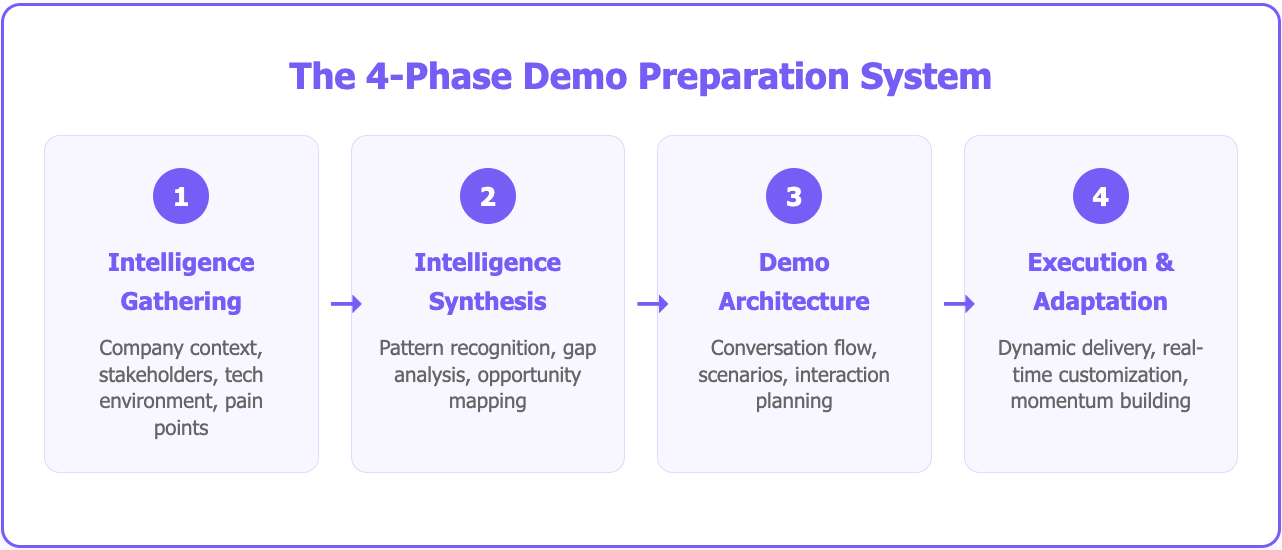
Phase 1: Intelligence Gathering
Complete prospect research involves more than company background and basic demographics. Demo-ready intelligence gathering focuses on context that enables relevant conversations.
Company intelligence includes recent developments, strategic initiatives, competitive pressures, and market conditions that affect technology decisions. This context helps position solutions as responses to specific business situations rather than generic productivity improvements.
Stakeholder analysis identifies decision-makers, influencers, and users involved in technology evaluations. Understanding roles, priorities, and concerns for each stakeholder enables targeted messaging that addresses specific interests.
Technology environment assessment reveals current tools, integration requirements, data sources, and technical constraints that affect solution fit. This information enables specific implementation discussions rather than hypothetical scenarios.
Pain point identification goes beyond obvious problems to understand underlying causes, business impact, and previous attempts at solutions. Deep pain point analysis enables solution positioning that addresses root causes rather than symptoms.
Timing analysis uncovers events, deadlines, or changes that create urgency for new solutions. This might include upcoming renewals, budget cycles, compliance requirements, or strategic initiatives that influence purchasing timelines.
Phase 2: Intelligence Synthesis
Raw intelligence becomes actionable insights through systematic analysis that connects data points to demo strategy.
Pattern recognition identifies themes across different information sources that reveal prospect priorities and decision criteria. These patterns inform which solution capabilities to emphasize and which benefits to highlight.
Gap analysis compares prospect needs with current capabilities to identify specific areas where new solutions create value. This analysis enables precise value propositions rather than broad benefit statements.
Risk assessment evaluates potential concerns, objections, or barriers that might prevent solution adoption. Understanding these risks enables proactive addressing rather than reactive responses.
Opportunity mapping connects solution capabilities to specific prospect outcomes to create clear value stories that demonstrate business impact.
Message customization adapts standard value propositions to reflect prospect-specific context, priorities, and language that resonates with their unique situation.
Phase 3: Demo Architecture
Strategic demo design structures presentations to maximize prospect engagement and minimize information overload.
Conversation flow planning outlines how to move from prospect challenges to solution demonstrations in ways that feel natural rather than scripted. This involves preparing transition questions that maintain engagement while advancing the conversation.
Scenario development creates specific examples that reflect prospect's industry, size, and use cases rather than generic demonstrations that could apply to any company.
Interaction planning identifies opportunities for prospect participation through questions, feedback, or hands-on exploration that creates investment in the conversation.
Objection anticipation prepares responses to likely concerns based on prospect research and similar customer experiences. This preparation enables confident addressing of issues rather than defensive reactions.
Next step strategy defines clear outcomes for the demo conversation and specific actions that advance the sales process toward decision-making.
Phase 4: Execution and Adaptation
Dynamic demo delivery adapts prepared strategies based on real-time prospect feedback and conversation direction.
Opening strategy uses researched insights to create immediate relevance that captures attention and establishes credibility. Strong openings reference specific prospect context rather than generic industry challenges.
Engagement monitoring tracks prospect questions, comments, and body language to gauge interest and adjust presentation accordingly. This includes recognizing when to go deeper into topics versus when to move on.
Real-time customization modifies demonstrations based on prospect feedback to address emerging questions or concerns that weren't anticipated during preparation.
Value reinforcement connects each solution capability to specific prospect outcomes throughout the conversation rather than leaving value connections implicit.
Momentum building creates excitement for next steps by helping prospects visualize success scenarios enabled by solution implementation.
What Research Reveals About Demo Optimization
Advanced demo optimization goes beyond basic prospect research to create systematic advantages that compound over multiple sales conversations.
Behavioral Pattern Recognition
Prospect behavior analysis reveals decision-making patterns that inform demo strategy beyond obvious company characteristics.
Communication preferences show how prospects prefer to receive information, whether they value detailed analysis or high-level overviews, and how they respond to different presentation styles.
Decision timeline analysis identifies factors that accelerate or delay purchasing decisions based on similar customer experiences and prospect-specific circumstances.
Risk tolerance assessment reveals how prospects evaluate new solutions, what level of proof they require, and what concerns typically prevent adoption.
Technology adoption patterns show how prospects have implemented similar solutions, what factors drove successful adoption, and what obstacles created implementation challenges.
These behavioral insights enable demo customization that aligns with prospect preferences rather than salesperson assumptions about effective presentation approaches.
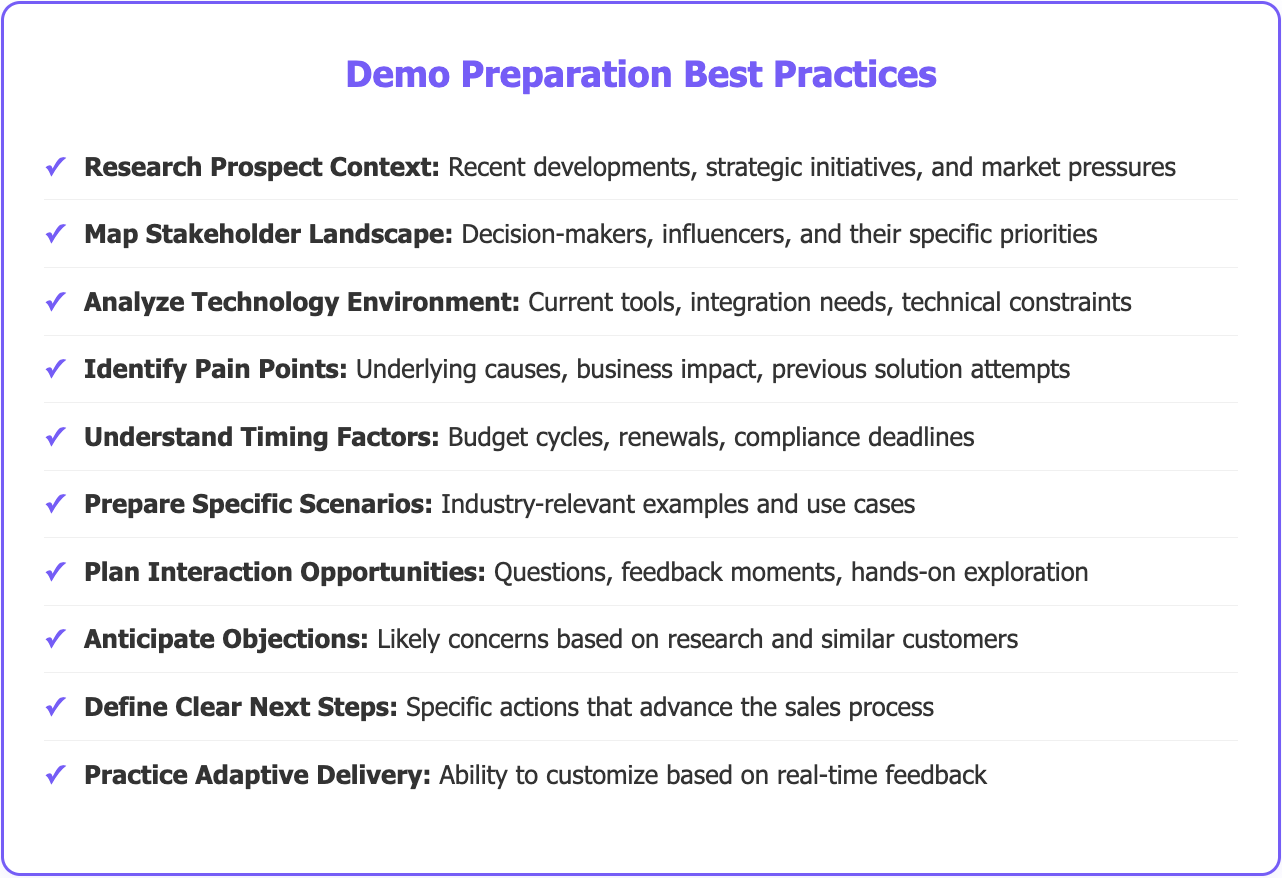
Competitive Intelligence Integration
Advanced competitive analysis provides context about how prospects are evaluating alternatives and what criteria they're using for vendor comparison.
Alternative solution mapping identifies what prospects are comparing you against, including do-nothing scenarios, internal development, and competitive solutions.
Evaluation criteria analysis reveals what factors prospects prioritize when choosing between alternatives, enabling strategic positioning that emphasizes your advantages.
Decision influence identification shows which stakeholders drive vendor selection and what arguments resonate with different decision-makers.
Timing advantage uses competitive intelligence to position demos at optimal moments in prospect evaluation cycles.
ROI Conversation Preparation
Value demonstration requires connecting solution capabilities to measurable business outcomes that justify investment costs.
Baseline establishment uses prospect research to understand current state performance metrics that serve as improvement baselines.
Outcome modeling projects specific improvements prospects can expect based on similar customer experiences and prospect-specific circumstances.
Investment justification prepares clear ROI calculations that address prospect budget constraints and approval requirements.
Risk mitigation demonstrates how solution implementation reduces business risks or regulatory compliance concerns.
Success metrics definition establishes clear criteria for measuring solution effectiveness that align with prospect business objectives.
How Databar Automates Demo Preparation
Traditional prospect research requires hours of manual investigation across multiple platforms to gather fragments of information that might inform demo preparation.
Databar eliminates this inefficiency by providing comprehensive prospect intelligence that transforms demo preparation from time-intensive research to strategic conversation planning.
Complete Prospect Context in Minutes
Manual research challenges include incomplete information, outdated data, and time constraints that limit research depth before demo calls.
Our automated enrichment provides comprehensive prospect profiles that include company intelligence, stakeholder details, technology environments, and behavioral signals that inform demo strategy.
Company intelligence includes recent developments, strategic initiatives, financial performance, and market position that helps position solutions within broader business context.
Stakeholder analysis provides detailed profiles of decision-makers, influencers, and users involved in technology evaluations, including their roles, responsibilities, and professional backgrounds.
Technology landscape mapping reveals current tools, integration requirements, and technical constraints that affect solution fit and implementation planning.
Behavioral insights show engagement patterns, content preferences, and decision-making indicators that inform demo customization and messaging strategy.
This comprehensive intelligence enables strategic demo preparation that addresses specific prospect context rather than generic industry challenges.
AI-Powered Demo Intelligence
Databar's AI capabilities analyze prospect data to surface insights that directly impact demo effectiveness and conversation strategy.
Contextual insight generation identifies patterns in prospect data that suggest specific pain points, opportunities, or timing considerations that affect technology decisions.
Competitive intelligence reveals what alternatives prospects are likely considering and what criteria they typically use for vendor evaluation.
Timing optimization identifies signals that indicate optimal demo timing based on business cycles, technology refresh schedules, or strategic initiatives.
Stakeholder prioritization helps focus demo preparation on decision-makers most likely to influence vendor selection.
For example, when preparing for a demo with a growing technology company, Databar can automatically identify that they've recently completed Series B funding, expanded their engineering team by 40%, and are using competitive solutions that create integration challenges. This intelligence enables demo positioning that addresses scale challenges and integration requirements rather than generic productivity benefits.
Automated Demo Preparation Workflows
Our workflow automation capabilities streamline demo preparation by systematizing research, analysis, and conversation planning activities.
Research automation gathers prospect intelligence from multiple sources without manual investigation across different platforms.
Insight synthesis analyzes collected data to identify patterns, priorities, and opportunities that inform demo strategy.
Conversation planning suggests demo approaches based on prospect characteristics and successful strategies with similar customers.
Follow-up optimization tracks demo outcomes and refines preparation strategies based on conversion patterns and prospect feedback.
For instance, a demo preparation workflow might automatically research a prospect company, analyze their technology stack, identify decision-makers, generate conversation starters, and suggest solution positioning based on similar successful demos.
The Metrics That Actually Predict Demo Success
Demo performance measurement requires tracking outcomes beyond basic conversion rates to understand what preparation strategies produce sustainable sales results.
Engagement Quality Indicators
Meaningful demo success involves prospect behaviors that indicate genuine interest rather than polite participation in sales conversations.
Question volume and quality shows whether prospects are actively engaging with solution concepts or passively listening to presentations. Engaged prospects ask specific questions about implementation, integration, and outcomes.
Conversation extension measures whether demos run longer than scheduled time because prospects want to explore additional topics or scenarios.
Stakeholder expansion tracks whether initial demo participants invite additional colleagues to follow-up conversations or request separate demonstrations for different teams.
Technical depth requests indicate whether prospects want detailed implementation discussions, integration requirements, or security compliance information.
These engagement indicators predict conversion likelihood better than simple response metrics because they demonstrate genuine evaluation rather than courtesy meetings.
Preparation Impact Analysis
Preparation effectiveness measurement identifies which research activities and intelligence types produce better demo outcomes.
Research depth correlation shows whether additional prospect intelligence improves conversion rates enough to justify extended preparation time.
Intelligence type analysis reveals which prospect insights most directly impact demo success for different customer segments or solution categories.
Competitive differentiation measurement tracks whether competitive intelligence enables better positioning against alternative solutions.
Timing optimization results identify whether prospect behavioral signals accurately predict optimal demo scheduling.
Pipeline Velocity Acceleration
Demo effectiveness ultimately measures how well preparation strategies accelerate prospects through purchase decision processes.
Sales cycle reduction tracks whether enriched prospect intelligence shortens time from demo to purchasing decision.
Deal size optimization measures whether deeper prospect understanding enables solution positioning that increases average contract values.
Win rate improvement compares conversion rates for demos prepared with enriched intelligence versus standard research approaches.
Customer success prediction identifies whether demo preparation insights correlate with successful solution implementation and customer satisfaction.
Stop Winging Your Demos
Demo success isn't optional for sales teams that want predictable pipeline growth and quota achievement.
The companies that consistently convert prospects into customers don't rely on presentation skills or product knowledge alone. They systematically gather prospect intelligence that enables relevant conversations prospects can't have with competitors.
This approach requires more preparation than standard demo processes, but prevents the much larger costs of failed demos, extended sales cycles, and lost competitive battles that result from generic presentations.
Effective demo preparation provides insights that improve not just individual conversations but entire sales strategies. Understanding what resonates with prospects informs product positioning, competitive differentiation, and go-to-market approaches across all channels.
The most successful approach focuses on understanding prospect context and business outcomes rather than showcasing product features or technical capabilities. When demos address specific problems using relevant solutions, engagement and conversions follow naturally.
Start with systematic prospect intelligence before perfecting presentation tactics. Identify specific insights that would make your demos more relevant. Research prospect context that enables meaningful conversations.
Measure outcomes rather than just activities. Track conversion quality, sales cycle velocity, and customer success indicators that predict revenue impact rather than just demo completion rates.
Scale successful approaches systematically rather than hoping that better presentation skills will improve results with inadequate preparation.
Most importantly, treat demo preparation as a competitive capability rather than a pre-call activity. Prospects remember conversations that demonstrate understanding of their world, and that understanding requires intelligence that most competitors don't invest time to gather.
If you're ready to stop treating demos like product presentations and start creating conversations that prospects can't ignore, explore how Databar provides in-depth prospect intelligence that turns demo preparation from guesswork into systematic competitive advantage.
Because in a world where 50% of buyers expect product demos during initial meetings, preparation isn't just helpful.
It's the only way to win.
Frequently Asked Questions
How much time should I spend researching prospects before demos?
Effective prospect research typically requires 30-45 minutes per demo prospect, but this investment can reduce sales cycle length by 30-50% compared to generic demo approaches. Focus research time on intelligence that directly impacts conversation relevance rather than exhaustive background investigation. Use data enrichment tools to gather comprehensive prospect profiles more efficiently than manual research.
What specific information should I research before demos?
Priority research areas include company context (recent developments, strategic initiatives), stakeholder analysis (decision-makers and their priorities), technology environment (current tools and integration requirements), competitive landscape (alternatives being considered), and timing factors (budget cycles, renewal dates, strategic deadlines). This information enables specific value propositions rather than generic benefit statements.
How do I customize demos without extending preparation time significantly?
Develop template frameworks that can be quickly customized based on prospect intelligence rather than creating unique presentations for each demo. Focus customization on opening statements, specific examples, and outcome positioning that reflect prospect context. Use enriched prospect data to personalize key conversation points while maintaining standard demo structure for efficiency.
What if prospects ask questions I'm not prepared for during demos?
Comprehensive prospect research typically covers 80-90% of likely questions, but preparation should include strategies for handling unexpected inquiries. Acknowledge questions honestly, offer to research specific details, and use questions as opportunities to understand prospect priorities better. Follow up quickly with researched answers to maintain momentum and demonstrate responsiveness.
How do I measure whether enriched prospect research actually improves demo results? Track conversion rates from demo to next step, average sales cycle length, deal size progression, and prospect engagement quality. Compare these metrics between demos prepared with enriched intelligence versus standard research approaches. Most teams see 25-40% improvement in conversion rates with systematic prospect intelligence.
Related articles
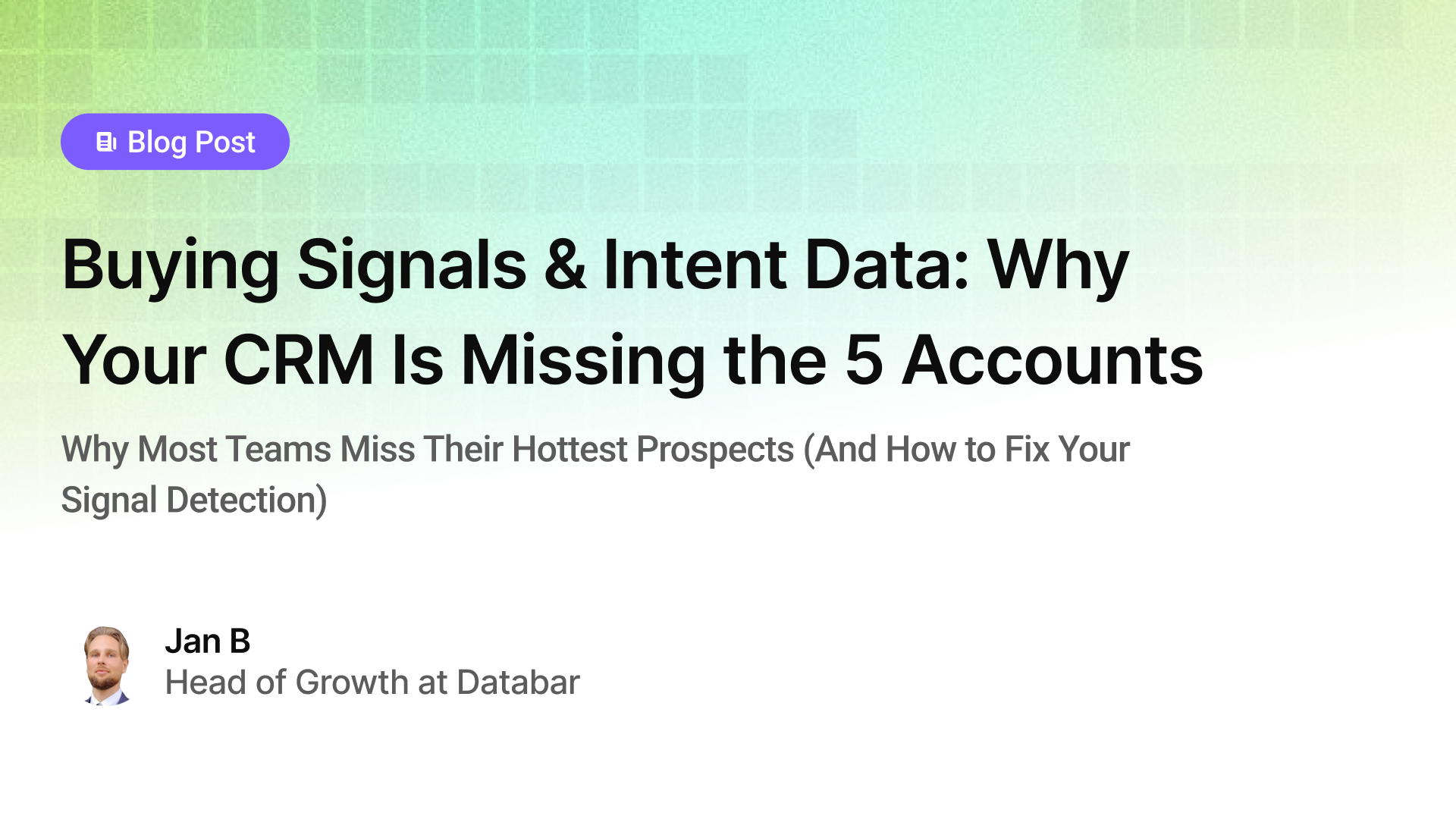
Buying Signals & Intent Data: Why Your CRM Is Missing the 5 Accounts
Why Most Teams Miss Their Hottest Prospects (And How to Fix Your Signal Detection)
by Jan, October 06, 2025

Lead Scoring & Account Segmentation: Why Most CRMs Get This Backward (And How to Fix It)
How to build a system that tells your team who to call, when, and why
by Jan, October 06, 2025
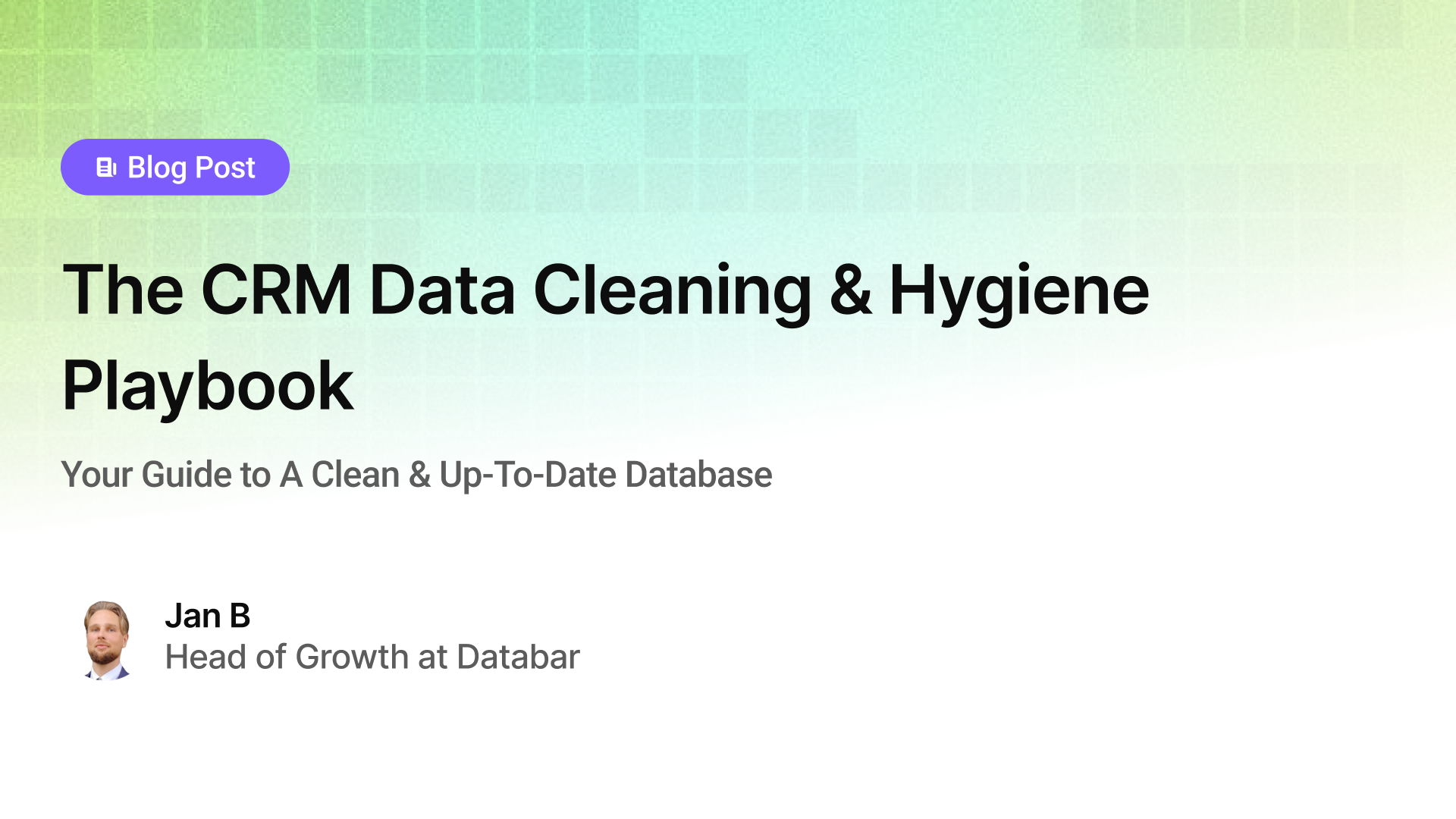
The CRM Data Cleaning & Hygiene Playbook
Your Guide to A Clean & Up-To-Date Database
by Jan, October 04, 2025
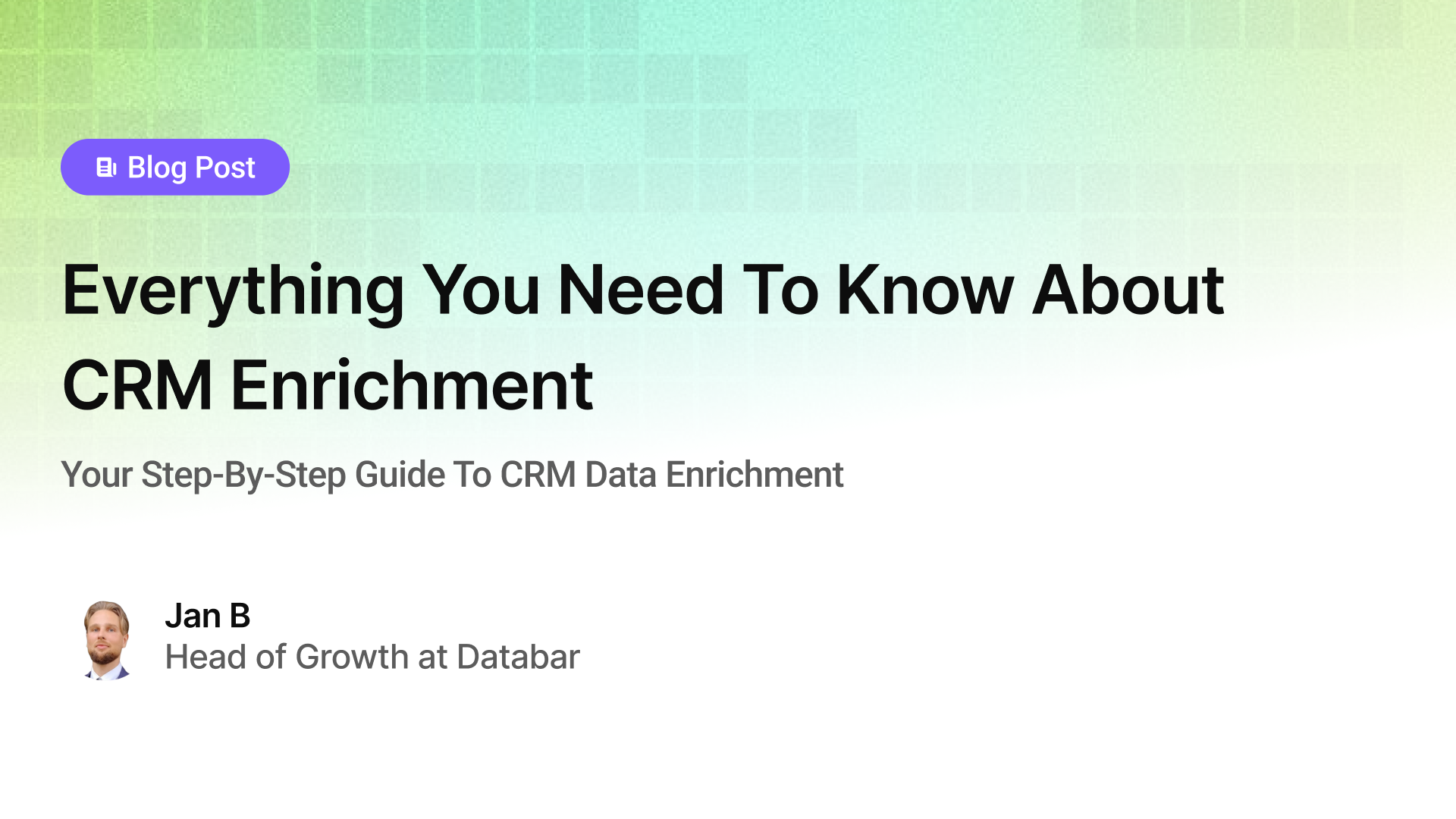
Everything You Need To Know About CRM Enrichment
Your Step-By-Step Guide To CRM Data Enrichment
by Jan, October 03, 2025

